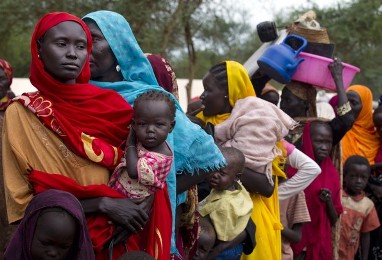Over 2,600 refugees flee conflict in SPLM-N areas in South Kordofan: OCHA
October 20, 2013 (KHARTOUM) – More than 2,600 Sudanese refugees have fled rebel-held areas in South Kordofan amid ongoing conflict and worsening food shortages in the region, aid agencies say.

According to OCHA, Médecins Sans Frontières (MSF) reported that 2,500 new refugees had crossed into South Sudan’s Upper Nile state on 11 October.
MSF said many of the new arrivals are women and children who had walked for five to 10 days, after fleeing their homes in the Warni and Kau Nyaro areas in south-east South Kordofan.
Some of new refugees arriving in Upper Nile state’s Kodok and Lelo towns told MSF that they had left their homes due to ongoing conflict between the Sudan Armed Forces (SAF) and the rebel Sudan People’s Liberation Movement-North (SPLM) forces, as well as a growing lack of food following two consecutive poor harvests.
FOOD CRISIS
The USAID-funded Famine Early Warning Systems Network (FEWS NET) reports that internally displaced persons (IDPs) in the SPLM-N-controlled areas of South Kordofan are facing an emergency situation due to acute food insecurity.
It predicts IDPs in these areas will rank under phase four – the highest level of its integrated food security phase classification (IPC) system.
Poor households in these areas are also facing a food crisis, with the situation likely to reach IPC phase three level.
The South Kordofan Humanitarian Aid Commission (HAC) has reported that 125 individuals, mainly women and children, have arrived in the Dalami locality of South Kordofan after fleeing the SPLM-N-controlled Tongoli area.
New arrivals said ongoing heavy fighting between SAF and SPLM-N forces had forced them to abandon their homes.
HAC said the newly-arrived refugees are in need of basic healthcare services, food assistance and emergency shelter.
On 9 October, as part of an emergency response to the situation, international NGO Concern Worldwide dispatched 125 kits to Dalami locality containing non-food relief supplies.
OCHA said the World Food Programme (WFP) will verify the newly displaced people later this month.
REFUGEES RETURN TO BLUE NILE
Meanwhile, aid agencies on the ground in Blue Nile say more refugees and IDPs continue to return to their areas of origin in Geissan and Kurmuk localities.
According to the OCHA bulletin, an NGO working on protection and tracking of IDPs movement in Blue Nile state had reported that an estimated 100 refugees returned to Geissan locality from the areas of Sharkloyy, Ahagar and Taiba in Ethiopia
The returnees are temporarily staying in schools in Geissan town and are yet to receive humanitarian aid.
The same NGO reported that an estimated 2,750 displaced people have returned to their areas of origin in Badug and Katalo in Kurmuk locality.
According to OCHA, some 2,000 newly-displaced people in Kurmuk locality remain in need of humanitarian assistance.
On 7-8 October, an inter-agency mission visited Bulang, Gambard and Diglok locations in Kurmuk locality to assess the humanitarian situation on the ground.
According to the mission’s preliminary findings, an estimated 2,500 displaced people reportedly fled Kalato and Shatayo villages because of fighting in late September.
The mission found that the IDPs in the area are in urgent need of emergency relief supplies, healthcare and shelter, as the public school building where they are currently staying will reopen after the Eid holiday.
According to the UN Refugee Agency (UNHCR), some 197,000 Sudanese refugees from South Kordofan and Blue Nile states have sought shelter in camps in Unity and Upper Nile states since 2011.
In the same period, an estimated 32,000 refugees, mainly from Blue Nile, have fled to the Assosa region of Ethiopia.
HUMANITARIAN GAP
In neighbouring South Kordofan, HAC says major gaps continue to exist in the provision of basic services for people who have returned to the Abu Kershola area, having fled fighting between the SAF and the Sudanese Revolutionary Front (SRF) in mid-April.
According to HAC, some 900 children who returned from El Rahad in North Kordofan lack access to education, with medicines, healthcare services and food supplies also lacking.
HAC says some 10,600 people have returned to Abu Kershola, where returnees are limited in their movement due to fears of unexploded ordnance (UXO) throughout the area.
The OCHA bulletin says there are reports of a continuous movement of returnees and displaced people between Abu Kershola and El Rahad in search of humanitarian assistance.
(ST)
